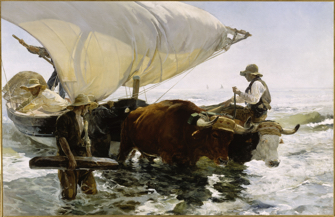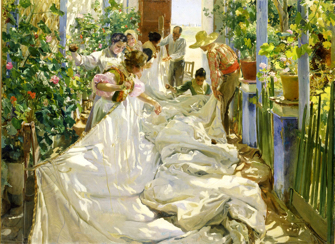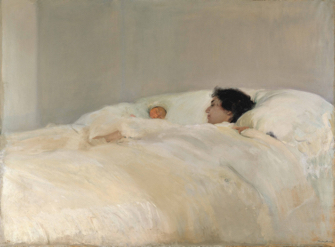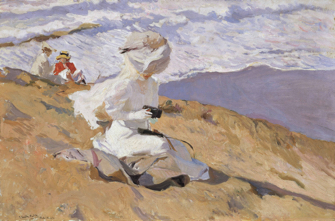Technical Wizardry
Lights Up the Canvas

“The Return from Fishing” (1894). © Musée d’Orsay, Paris, Photo: Gérard Blot/Hervé Lewandowski
The paintings of Joaquín Sorolla y Bastida (1863-1923) are full of bravura technical wizardry. Even as a youngster, the Spanish artist was hailed as a genius and compared with Velázquez after he submitted pictures to, and won, the most prestigious art competitions in Europe. Groomed for stardom in Madrid, Rome and Paris by wealthy benefactors, this orphan son of a Valencia merchant went on to become the most fashionable artist of his day, achieving huge success in the United States. His work is currently on show in the exhibition “Sorolla: The Paris Years” at the Musée des Impressionnismes in Giverny.
When he was just 27, his monumental work “Another Marguerite” won a gold medal at the Madrid National Exhibition and then took first prize at the 1893 World’s Columbian Exposition. The huge and melancholy “Sad Inheritance” (in this show), featuring disabled children on a beach, guarded by a black-robed priest, earned him the medal of honor at the Exposition Universelle of 1900 in Paris.
This success enabled Sorolla to travel widely and accept commissions, notably from wealthy Americans avid for portrayals or “typical” scenes of traditional Spanish life. Among these is the impressive “Sewing the Sail” (1896), in which we see five seamstresses attending to

“Sewing the Sail” (1896) © Venice, 2015. Photo: Archive Fondazione Musei Civici di Venezia
a dazzlingly white sail against a backdrop of sun-drenched begonias.
In “Valencian Fishermen” (1895), he demonstrates his mastery of sparkling light on water. As the fishermen open their lobster pots on the shore, their boat approaches, riding a light surf. Every detail is brilliantly executed, with astounding light and shade effects.
In 1909 he was invited to stage a lavish show in New York. It attracted 160,000 visitors and led to a commission to paint a portrait of President William Howard Taft at the White House (unfortunately, this work is not in the Giverny exhibition).
Some of Sorolla’s most famous works depict little boys playing in the water. Like his contemporary and friend, John Singer Sargent, the artist devised a brilliant language of color to depict rippling water, an aquatic utopia in which the naked pre-pubescent figures frolic. It’s all in the best possible taste.
Sorolla’s use of white, shades of white and light pastel tones produces effects which, as intended, conjure up a paradisiacal notion of sunny Spain. Among such works, mention must be made of “Mother” (1895), showing his

“Mother” (1895–1900). © Museo Sorolla, Madrid
wife, Clotilde Garcia des Castillo, in bed with their child. The tiny baby and the mother’s head are the only splashes of colour amid the snowy sheets and pillows. Even the wall behind is blank.
In 1906, Sorolla was invited to exhibit again in Paris. He put on a show of no fewer than five hundred works at the Georges Petit gallery, an event that proved highly profitable. Sorolla was by then one of the most sought-after portraitists in the world.
Some of his elegant later beach paintings, such as “Snapshot, Biarritz” (1906) show fashionably dressed (in white, of course) ladies

“Snapshot, Biarritz” (1906). © Museo Sorolla, Madrid
sitting on windy beaches, their extravagant hats and copious summer dresses blowing about in the breeze. The effects of shadow, wind-swept muslin and pinky-cream surf rippling across pastel sand are memorable. It’s easy to see why moneyed Americans of the period might have wanted a couple to decorate their grand houses.
These marvellous pictures, produced with extraordinary dexterity – like the extravagant architecture, machinery, music and art of the late Victorian and Edwardian Ages – are ultimately reflections of the cultural values of an important period in history, governed by codes which were soon to be shattered by World War I.
The prolific, overworked Sorolla died in 1923 in Madrid, two years after being paralyzed by a stroke. His home/studio in the Spanish capital is today the Sorolla Museum. I warmly recommend a visit.
Musée des Impressionnismes Giverny: 99, rue Claude Monet, Giverny. Take train from Gare Saint Lazare to Vernon, then shuttlebus (outside train station). Tel: 02 32 51 94 65. Open daily, 10am-6pm. Through November 6, 2016. Admission: €7 (combined ticket with Monet’s house and garden: €16.50). www.mdig.fr
Reader reaction: Click here to respond to this article (your response may be published on this page and is subject to editing).
More reviews of Paris art shows.
© 2016 Paris Update
Favorite